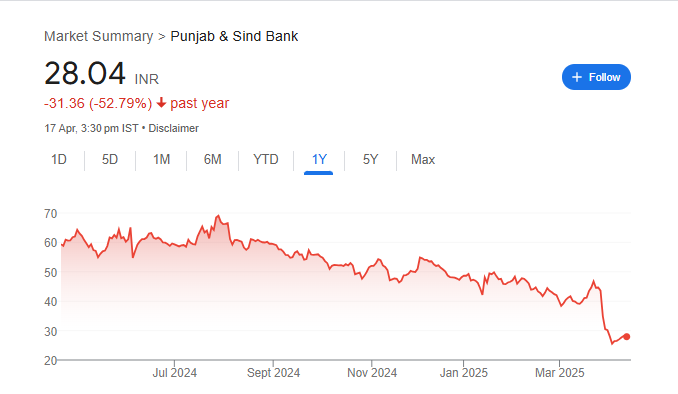Punjab and Sind Bank Share Price Target 2025 – Share Market Update
Punjab & Sind Bank is a government-owned bank that offers various banking and financial services across India. The company’s shares are listed on the stock exchange and attract interest from investors looking for exposure to the public sector banking space. Over the years, the bank has worked on improving its financial health, reducing bad loans, and maintaining a stable capital base. Punjab and Sind Bank Share Price on NSE as of 18 April 2025 is 28.04 INR.
Current Market Overview Of Punjab and Sind Bank Share
- Open: 28.16
- High: 28.39
- Low: 27.85
- Mkt cap: 19.00KCr
- P/E ratio: 22.46
- Div yield: 0.71%
- 52-wk high: 73.64
- 52-wk low: 25.22
Punjab and Sind Bank Share Price Chart

Shareholding Pattern For Punjab and Sind Bank
- Promoter: 93.85%
- FII: 0.73%
- DII: 4.32%
- Public: 1.1%
Punjab and Sind Bank Share Price Target Tomorrow
| Punjab and Sind Bank Share Price Target Years | Punjab and Sind Bank Share Price Target Months | Punjab and Sind Bank Share Price |
| Punjab and Sind Bank Share Price Target 2025 | April | ₹35 |
| Punjab and Sind Bank Share Price Target 2025 | May | ₹40 |
| Punjab and Sind Bank Share Price Target 2025 | June | ₹45 |
| Punjab and Sind Bank Share Price Target 2025 | July | ₹50 |
| Punjab and Sind Bank Share Price Target 2025 | August | ₹55 |
| Punjab and Sind Bank Share Price Target 2025 | September | ₹60 |
| Punjab and Sind Bank Share Price Target 2025 | October | ₹65 |
| Punjab and Sind Bank Share Price Target 2025 | November | ₹70 |
| Punjab and Sind Bank Share Price Target 2025 | December | ₹75 |
Key Factors Affecting Punjab and Sind Bank Share Price Growth
Here are six key factors that can influence the growth of Punjab & Sind Bank’s share price:
1. Improved Asset Quality
Punjab & Sind Bank has made significant progress in reducing its non-performing assets (NPAs). As of the latest financial reports, the Gross NPA ratio stands at 4.21%, and the Net NPA ratio is at 1.46%, indicating better asset quality and efficient credit management.
2. Consistent Profit Growth
The bank has shown a steady increase in net profits over recent years. For instance, the net profit for the financial year ended March 2023 was ₹1,313.03 crore, up from ₹1,039.05 crore in the previous year, reflecting a positive growth trend.
3. Expansion in Retail and MSME Segments
Punjab & Sind Bank has been focusing on expanding its services in the Retail, Agriculture, and Micro, Small & Medium Enterprises (MSME) sectors. This strategic emphasis has led to notable growth in deposits and advances within these segments, contributing to the bank’s overall performance.
4. Digital Transformation Initiatives
The bank is investing in digital technologies to enhance customer experience and operational efficiency. Efforts towards digital transformation, including innovative lending solutions, are expected to attract a broader customer base and improve service delivery.
5. Strong Capital Adequacy
Maintaining a healthy capital adequacy ratio is crucial for a bank’s stability and growth. Punjab & Sind Bank’s consistent efforts to strengthen its capital base provide a solid foundation for future expansion and resilience against financial uncertainties.
6. Government Ownership and Support
As a public sector bank, Punjab & Sind Bank benefits from government backing, which can instill confidence among investors. Government ownership often implies support in times of financial stress, contributing to the bank’s credibility and stability in the market.
Risks and Challenges for Punjab and Sind Bank Share Price
Here are six key risks and challenges that could influence Punjab & Sind Bank’s share price:
1. High Cost-to-Income Ratio
Punjab & Sind Bank has a cost-to-income ratio of 62.82%, indicating that a significant portion of its income is consumed by operating expenses. This high ratio suggests potential inefficiencies in managing operational costs, which could impact profitability and, consequently, the share price.
2. Stock Price Volatility
The bank’s stock has experienced significant volatility, recently hitting a new 52-week low of ₹35.05. Such fluctuations can affect investor confidence and may lead to cautious investment behavior, influencing the share price negatively.
3. Challenges in Capital Raising
Punjab & Sind Bank plans to raise ₹2,000 crore through a Qualified Institutional Placement (QIP) at a floor price of ₹40.38 per share. However, if market conditions are unfavorable or investor interest is low, the bank may face challenges in successfully raising the desired capital, which could impact its expansion plans and share price.
4. Dependence on Government Support
As a public sector bank, Punjab & Sind Bank relies on government support for capital infusion and policy backing. Any changes in government policies or reduced support could affect the bank’s operations and financial stability, potentially impacting the share price.
5. Exposure to Non-Performing Assets (NPAs)
While the bank has made progress in reducing its Gross NPA to 4.21% and Net NPA to 1.46%, it still carries a restructured book of ₹1,974 crore. Any deterioration in asset quality or increase in NPAs could necessitate higher provisions, affecting profitability and share price.
6. Competitive Banking Environment
The Indian banking sector is highly competitive, with numerous public and private sector banks vying for market share. Punjab & Sind Bank may face challenges in maintaining its customer base and margins amidst this competition, which could influence its financial performance and share price.
Read Also:- IndiaMART Share Price Target 2025 – Share Market Update

